Kurumathur inscription
Kurumathur inscription (871 AD), also romanised as Kurumattur, is a mid-9th century inscription from Kurumathur, near Areacode in Kerala, south India. The Sanskrit inscription in Pallava Grantha script is engraved on a loose granite slab from the Kurumathoor Vishnu temple.[1][2][3] It is one of the rare Sanskrit inscriptions from Kerala.[1]

The inscription relates to the rule of Chera Perumal king Rama Rajasekhara (9th century AD) in north-central Kerala.[1][4] It is dated to 24 May 871 AD as a Kali Day chronogram.[4] Composed in shardula-vikridita metre in Sanskrit, the three-stanza inscription states that the king Rajasekhara belonged to the illustrious Ikshvaku dynasty of god Rama.[2] It wishes that king Rajasekhara's glory be spread across the oceans. Further, he is extolled as having ruled the country with justice and never deviated from the Laws of Manu.[2] During his righteous rule twelve Brahmanas constructed a temple pond and also installed an idol of god Vishnu in the temple.[2][3]
The record was excavated during a renovation of Kurumathoor Vishnu temple (south of Areacode) in February, 2011.[2][3] The discovery of the inscription was reported by M. R. Raghava Varier.[1]
References
- Veluthat, Kesavan (1 June 2018). "History and historiography in constituting a region: The case of Kerala". Studies in People's History. 5 (1): 13–31.
- Indian Archaeology 2010-2011 – A Review (2016) (p. 118)
- Naha, Abdul Latheef. Ancient inscription throws new light on Chera history. 11 February 2011 The Hindu
- 'Changes in Land Relations during the Decline of the Cera State,' In Kesavan Veluthat and Donald R. Davis Jr. (eds), Irreverent History:- Essays for M.G.S. Narayanan, Primus Books, New Delhi, 2014. 58.